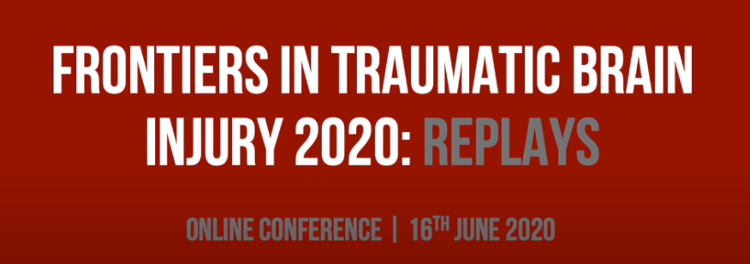
On the 16th June, over 1000 people gathered online for the 4th Frontiers in Traumatic Brain Injury (TBI) Conference. Although COVID-19 necessitated the move online from the conference’s usual base with the host Imperial College London, this facilitated the participation of a truly global collection of speakers and attendees.
The philosophy of the conference, as shared by David Sharp, Professor of Neurology at Imperial College London, in his introduction, is to try and bring together the exciting science in TBI which has been developing over a number of years with the clinical aspects.
The day itself was split into two streams, resulting in a total of around 20 hours of speaker content, some of which is being made available after the event through the Frontiers in TBI YouTube channel. The bulk of this was dedicated to the vast variety of research which is advancing understanding in traumatic brain injury, and included rapid-fire presentations and online posters as well as more detailed dives into specific subject areas. There were also two teaching sessions, in which experienced clinicians discussed current management of patients with TBI, as well as an extended session around the legal aspects of TBI.
Neuroinflammation
One key theme emerging from the conference was the importance of neuroinflammation in damage to the brain following trauma. Soyon Hong, group leader at the UK Dementia Research Institute, University College London, detailed her team’s research into the role microglia play in neuroinflammation, with particular consideration of their importance in synapse loss and dysfunction. The role of microglia in neuroinflammation was further developed by David Loane, Associate Professor at the Shock, Trauma and Anaesthiology Research Center, University of Maryland, who reported evidence that delayed microglial depletion can avoid the presence of chronically activated microglia and improve motor and cognitive recovery after TBI in animal models.
Neuroinflammation after TBI can also be exploited clinically through the use of biomarkers to understand severity of injury to the brain. Henrik Zetterburg, Professor of Neurochemistry at the University of Gothenburg and University College London highlighted serum neurofilament light (NfL) as a promising biomarker for neuronal injury, and demonstrated its association with concussive symptoms in players of high-risk sports. The use of biomarker S100 calcium binding protein B (S100B) has already been incorporated into Scandinavian guidelines for management of head trauma, as explained by Eric Thelin, a post-doctoral researcher at the Karolinska Institut, who also noted the importance of correct patient selection to avoid risk of high numbers of false positives.
Another key theme was the importance of considering not only isolated lesions, but also the impact on associated white matter tracts. Michel Thiebaut de Schotten, a tenured research director at the French National Centre for Scientific Research, presented his pioneering work establishing the Disconnectome map of white matter tracts, enabling researchers to understand these impacts on an individual patient level. Furthermore, Celia Demarchi, a clinical psychologist from Imperial College London, demonstrated how using diffusion tensor MRI in combination with neuropsychological testing had enabled her team to establish correlations between damage to particular white matter tracts and specific neuropsychological deficits in adolescents with TBI.
Prevention of TBI
One important challenge considered by the conference was the prevention of TBI. Risk of TBI in sport is well recognised, and Stefan Duma, Henry Wyatt Professor of Engineering at Virginia Tech, presented evidence challenging preconceptions about the lack of protection afforded by helmets in sport, and instead encouraged consideration of the role they may play within reducing risk of TBI. However, brain injury in sport is a relatively well studied field compared to the risk presented by intimate partner violence, as Jonathan Lifshitz, Professor of Child Health at the University of Arizona, highlighted, also noting that symptoms are often dismissed as being psychogenic. In addition, Yasmina Molero Plaza, a researcher at the Karolinska Institute, discussed her team’s work using registries of the entire Swedish population, which demonstrated that, compared to controls, individuals experiencing TBI were more likely to be receiving medication, including psychotropic and pain medication, not only after but also before their injury, raising important questions about the reasons for this correlation.
How can adverse effects be mitigated?
Another challenge is how the adverse effects of TBI can be mitigated. Mark Wilson, Clinical Professor at Imperial College London, spoke on the importance of early management of head trauma to prevent secondary brain injury. To this end, he has co-founded GoodSAM, enabling rapid video assessment of emergency situations to improve triage, in accordance with his mantra that if you’re not dead when the ambulance arrives, you shouldn’t die. Management of longer term impacts of TBI is also crucial, and Jennie Ponsford, Professor of Neuropsychology at Monash University, presented research suggesting light therapy as a possible intervention for the commonly seen issues of fatigue and sleep disturbance after TBI.
The conference was concluded by David Sharp, starting with the awarding of prizes for rapid-fire presentations to Nick Parsons and Alexandre Trottier, and for poster presentation to Marie Hanscom. He reflected that the conference had helped to bring to light tremendous insights into the neuroscience of TBI, as well as highlighting the need for further experimental studies to bridge the gap between the basic science and clinical trials. Although deprived of a traditional round of applause by the online nature of the conference, the chat log was awash with comments expressing gratitude to the team for a fantastic conference, and no doubt many of the participants will already be looking forward to the planned 2021 conference.
To see the talks please visit: Frontiers in Traumatic Brain Injury YouTube Channel